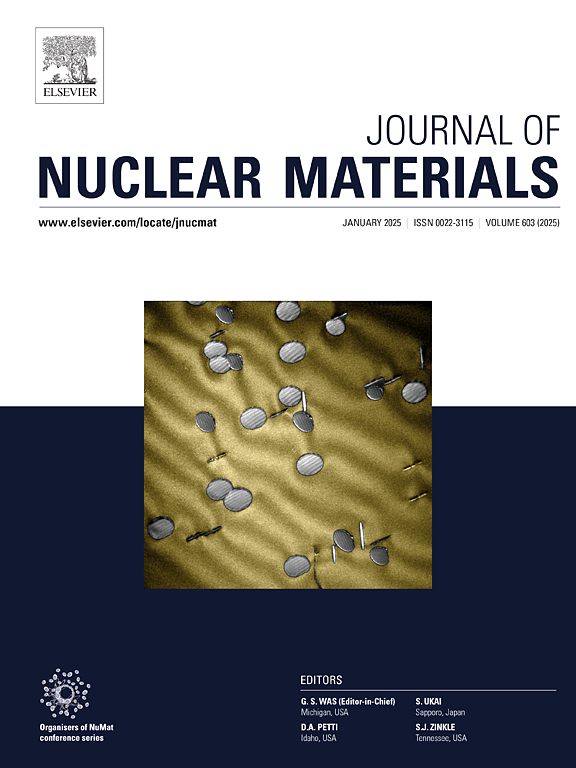Structural evolution and compressibility trends in Ce-doped UO2
IF 2.8
2区 工程技术
Q3 MATERIALS SCIENCE, MULTIDISCIPLINARY
引用次数: 0
Abstract
Ce-doped UO2 is an important material in nuclear research because the structural properties of Ce are similar to those of Pu. This makes Ce-doped UO2 a valuable surrogate for studying the behavior of Pu-doped UO2. Cerium doped UO2 samples U1-xCexO2 (x = 0.2, 0.4, 0.6, 0.8) were synthesized using sol-gel method. U1-xCexO2 retains fluorite UO2 structure with decreasing lattice parameter as Ce content is increased. The decrease in lattice parameter is due to the larger presence of tetravalent Ce cation than trivalent cations. In-situ high pressure x-ray diffraction studies were carried out to find out effect of doping Ce and study their compressibility behavior. These compounds remain in fluorite structure at least up to 25 GPa, beyond which phase transition to orthorhombic structure is seen. The ambient pressure bulk modulii for x = (0.2, 0.4, 0.8) in U1-xCexO2 are 216 (6) GPa, 225 (9) GPa, and 247 (8) GPa, respectively that indicates consistent increase in the bulk modulus of the material when Ce content is increased. The behavior of bulk modulus with Ce doping follows lattice parameter i.e. smaller lattice shows lesser compressibility.
ce掺杂UO2的结构演变和可压缩性趋势
Ce掺杂UO2是核研究中的一种重要材料,其结构性质与Pu相似。这使得ce掺杂UO2成为研究pu掺杂UO2行为的有价值的替代物。采用溶胶-凝胶法合成了掺杂铈的UO2样品U1-xCexO2 (x = 0.2, 0.4, 0.6, 0.8)。随着Ce含量的增加,U1-xCexO2仍保持萤石型UO2结构,晶格参数减小。晶格参数的减小是由于四价Ce阳离子比三价Ce阳离子存在更多。采用原位高压x射线衍射研究了掺杂铈的影响,并研究了其压缩行为。这些化合物保持萤石结构至少高达25gpa,超过25gpa,可以看到相转变为正交结构。当x =(0.2、0.4、0.8)时,U1-xCexO2的环境压力体积模量分别为216 (6)GPa、225 (9)GPa和247 (8)GPa,表明随着Ce含量的增加,材料的体积模量呈一致的增加趋势。Ce掺杂后的体模量遵循晶格参数,即晶格越小,可压缩性越小。
本文章由计算机程序翻译,如有差异,请以英文原文为准。
求助全文
约1分钟内获得全文
求助全文
来源期刊

Journal of Nuclear Materials
工程技术-材料科学:综合
CiteScore
5.70
自引率
25.80%
发文量
601
审稿时长
63 days
期刊介绍:
The Journal of Nuclear Materials publishes high quality papers in materials research for nuclear applications, primarily fission reactors, fusion reactors, and similar environments including radiation areas of charged particle accelerators. Both original research and critical review papers covering experimental, theoretical, and computational aspects of either fundamental or applied nature are welcome.
The breadth of the field is such that a wide range of processes and properties in the field of materials science and engineering is of interest to the readership, spanning atom-scale processes, microstructures, thermodynamics, mechanical properties, physical properties, and corrosion, for example.
Topics covered by JNM
Fission reactor materials, including fuels, cladding, core structures, pressure vessels, coolant interactions with materials, moderator and control components, fission product behavior.
Materials aspects of the entire fuel cycle.
Materials aspects of the actinides and their compounds.
Performance of nuclear waste materials; materials aspects of the immobilization of wastes.
Fusion reactor materials, including first walls, blankets, insulators and magnets.
Neutron and charged particle radiation effects in materials, including defects, transmutations, microstructures, phase changes and macroscopic properties.
Interaction of plasmas, ion beams, electron beams and electromagnetic radiation with materials relevant to nuclear systems.
 求助内容:
求助内容: 应助结果提醒方式:
应助结果提醒方式:


